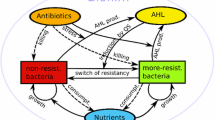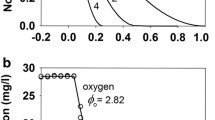Abstract
A mathematical model of the action of antimicrobial agents on bacterial biofilms is presented. The model includes the fluid dynamics in and around the biofilm, advective and diffusive transport of two chemical constituents and the mechanism of physiological resistance. Although the mathematical model applies in three dimensions, we present two-dimensional simulations for arbitrary biofilm domains and various dosing strategies. The model allows the prediction of the spatial evolution of bacterial population and chemical constituents as well as different dosing strategies based on the fluid motion. We find that the interaction between the nutrient and the antimicrobial agent can reproduce survival curves which are comparable to other model predictions as well as experimental results. The model predicts that exposing the biofilm to low concentration doses of antimicrobial agent for longer time is more effective than short time dosing with high antimicrobial agent concentration. The effects of flow reversal and the roughness of the fluid/biofilm are also investigated. We find that reversing the flow increases the effectiveness of dosing. In addition, we show that overall survival decreases with increasing surface roughness.
Similar content being viewed by others
References
Adams, L., Charter, T., 2004. New geometric immersed interface multigrid solvers. SIAM Journal on Scientific Computing 25, 1516–1533.
Allison, D., Gilbert, P., 1995. Modification by surface association of antimicrobial susceptibility of bacterial populations. Journal of Industrial Microbiology 15, 311–317.
Beyenal, H., Lewandowski, Z., 2001. Mass-transport dynamics, activity and structure of sulfate-reducing biofilms. AIChE Journal 47, 1689–1697.
Characklis, W.G., Marshall, K.C. (Eds.), 1990. Biofilms. John Wiley and Sons, Inc.
Chen, C.-I., Reinsel, M., Mueller, R., 1994. Kinetic investigation of microbial souring in porous media using microbial consortia from oil reservoirs. Biotechnology and Bioengineering 44, 263–269.
Cortez, R., 2001. The method of regularized Stokeslets. SIAM Journal of Scientific Computing 23, 1204–1224.
Cortez, R., Fauci, L., Medovikov, A., 2004. The method of regularized Stokeslets in three dimensions: analysis, validation, and application to helical swimming. Physics of Fluids (in press).
Costerton, J., Stewart, P.S., Greenberg, E.P., 1999. Bacterial biofilms: a common cause of persistent infections. Science 284, 1318–1322.
Davies, D., 2003. Understanding biofilm resistance to antibacterial agents. Nature Reviews Drug Discovery 2, 114–122.
DeBeer, D., Stoodley, P., Lewandowski, Z., 1996. Liquid flow and mass transfer in heterogeneous biofilms. Water Research 30, 2761–2765.
Dockery, J., Klapper, I., 2002. Finger formation in biofilm layers. SIAM Journal on Applied Mathematics 62, 853–869.
Dodds, M.G., Grobe, K.J., Stewart, P.S., 2000. Modeling biofilm antimicrobial resistance. Biotechnology and Bioengineering 68, 456–465.
Eberl, H., Picioreanu, C., Heijnen, J., van Loosdrecht, M., 2000. A three-dimensional numerical study on the correlation of spatial structure, hydrodynamic conditions, and mass transfer and conversion in biofilms. Chemical Engineering Science 55, 6209–6222.
Golub, G.H., Loan, C.F.V., 1996. Matrix Computations, 3rd edition. Johns Hopkins University Press.
Grobe, K., Zahler, J., Stewart, P., 2002. Role of dose concentration in biocide efficacy against Pseudomonas aeruginosa biofilms. Journal of Industrial Microbiology and Biotechnology 29, 10–15.
Hentzer, M., Wu, H., Andersen, J.B., Riedel, K., Rasmussen, T.B., Bagge, N., Kumar, N., Song, Z., Schembri, M., Kristoffersen, P., Manefield, M., Costerton, J.W., Molin, S., Eberl, L., Steinberg, P., Kjelleberg, S., Hoiby, N., Givskov, M., 2003. Attenuation of Pseudomonas aeruginosa virulence by quorum sensing inhibitors. The EMBO Journal 22, 3803–3815.
Klapper, I., Rupp, C., Cargo, R., Purvedorj, B., Stoodley, P., 2002. Viscoelastic fluid description of bacterial biofilm material properties. Biotechnology and Bioengineering 80, 289–296.
Lappin-Scott, H.M., Costerton, J.W. (Eds.), 1995. Mechanisms of the protection of bacterial biofilms from antimicrobial agents. In: Microbial Biofilms. Cambridge University Press, Cambridge, pp. 118–130.
Lewis, K., 2001. Riddle of biofilm resistance. Antimicrobial Agents and Chemotherapy 45, 999–1007.
Lighthill, J.M., 1986. An Informal Introduction to Theoretical Fluid Mechanics. Oxford University Press, New York.
Manem, J., Rittmann, B., 1992. Removing trace level organic pollutants in a biological filter. Journal of American Water Works 84, 152–157.
Picioreanu, C., van Loosdrecht, M.C., Heijnan, J.J., 2001. Two-dimensional model of biofilm detachment caused by internal stress from liquid flow. Biotechnology and Bioengineering 72, 205–218.
Potera, C., 1999. Forging a link between biofilms and disease. Science 283, 1837–1839.
Pozrikidis, C., 1998. Numerical Computation in Science and Engineering. Oxford University Press, New York.
Prakash, B., Veeregowda, B., Krishnappa, G., 2003. Biofilms: a survival strategy of bacteria. Current Science India 85, 1299–1307.
Roberts, M.E., Stewart, P.S., 2004. Modeling antibiotic tolerance in biofilms by accounting for nutrient limitation. Antimicrobial Agents and Chemotherapy 48, 48–52.
Sanderson, S.S., Stewart, P.S., 1997. Evidence of bacterial adaption to monochloramine in Pseudomonas aeruginosa biofilms and evaluation of biocide action model. Biotechnology and Bioengineering 56, 201–209.
Stewart, P.S., 2003. Diffusion in biofilms. Journal of Bacteriology 185, 1485–1491.
Stewart, P.S., Roe, F., Rayner, J., Elkins, J.G., Lewandowski, Z., Ochsner, U.A., Hassett, D.J., 2000. Effect of catalase on hydrogen peroxide penetration into Pseudomonas aeruginosa biofilms. Applied and Environmental Microbiology 66, 836–838.
Stoodley, P., Boyle, J.D., de Beer, D., Lappin-Scott, H.M., 1999. Evolving perspectives of biofilm structure. Biofouling 14(1), 75–90.
Stoodley, P., Jacobsen, A., Dunsmore, B., Purevdorj, B., Wilson, S., Lappin-Scott, H., Costerton, J., 2001. The influence of fluid shear and AlCl3 on the material properties of Pseudomonas aeruginosa PAO1 and Desulfovibrio sp. EX265 biofilms. Water Science and Technology 43, 113–120.
Sufya, N., Allison, D., Gilbert, P., 2003. Clonal variation in maximum specific growth rate and susceptibility towards antimicrobials. Journal of Applied Microbiology 95, 1261–1267.
Wanner, O., Reichert, P., 1996. Mathematical modeling of mixed-culture biofilms. Biotechnology and Bioengineering 49, 172–184.
Wingender, J., Neu, T.R., Fleming, H.-C., 1999. Microbial Extracellular Polymeric Substances. Characterization, Structure and Function. Springer-Verlag.
Yu, J., Ji, M., Yue, P., 1999. A three-phase fluidized bed reactor in the combined anaerobic/aerobic treatment of wastewater. Journal of Chemical Technology and Biotechnology 74, 619–626.
Zhang, X., Bishop, P.L., 2001. Spatial distribution of extracellular polymeric substances in biofilms. Journal of Environmental Engineering 127, 850–856.
Author information
Authors and Affiliations
Corresponding author
Rights and permissions
About this article
Cite this article
Cogan, N.G., Cortez, R. & Fauci, L. Modeling physiological resistance in bacterial biofilms. Bull. Math. Biol. 67, 831–853 (2005). https://doi.org/10.1016/j.bulm.2004.11.001
Received:
Accepted:
Issue Date:
DOI: https://doi.org/10.1016/j.bulm.2004.11.001




